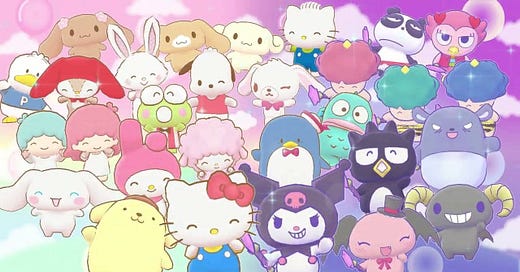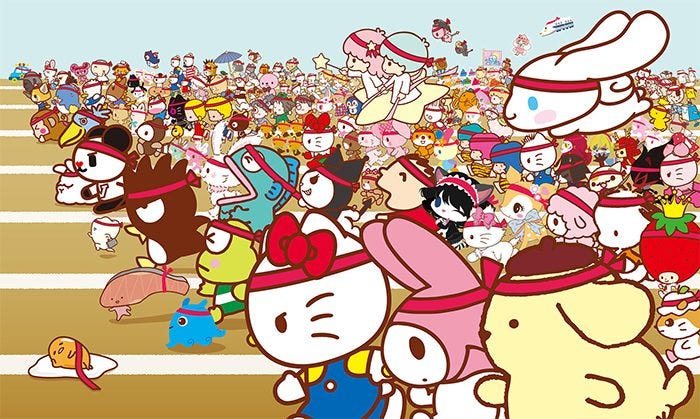SANRIO COMPANY (8136.T)
A family-controlled and run brand company behind Hello Kitty with a powerful moat and feedback loops going through a successful turnaround and trading below the intrinsic value.
Key Facts
Description: Sanrio Company is the creator and owner of Hello Kitty, Gudetama, My Melody, Cinnamoroll, Kuromi, Pompompurin and others with a portfolio of 400+ characters. Historically, the company made money by designing and selling products with its characters like social communication gifts, greeting cards, books, and almost anything else that can have a cute cat put on it. They also operate theme parks with the most famous one being Puroland in Tokyo, restaurants and cafes. It also organises live events and shows and produces movies and shows. Recently, it has been aggressively expanding into the IP licensing business, focusing on video games, shows, Web3 vtube and XR. Sanrio struggled until 2020 when it underwent drastic changes and began its turnaround with a new and unusually young CEO (31 years old) who’s also a grandson of the founder and a completely new and revamped strategy (more on that in point 3 of this analysis). It was founded in 1960 and is headquartered in Tokyo, Japan.
Track record: Sanrio was struggling with the operating income falling from the 2014 high of 21 billion JPY to 2.1 billion in 2020 and the first loss in 2 decades seen in 2021. A turnaround began around 2020/21 with the appointment of Tomokuni Tsuji as CEO and a new and aggressive strategy. The turnaround has worked and the operating profit rebounded to 2.5 billion JPY in 2022, 13.2 billion in 2023 and now to 27 billion in 2024 with more expected in the future as the company has poised for long-term growth. I break down the strategy and changes to its elements in point 3 of this deep dive after the business overview of point 2.
Market cap: As of the 18th of June 2024, its market cap is 649 billion JPY (~$4.1 billion). It has grown since January 1, 2024, from 1,958 to 2,748.5 JPY per share. It is also ~60% up from its 52-week low.
Valuation: 8136.T trades at a TTM P/E of 38.29x (4-year average of ~99.2x), which is going to compress (look point 8), EV/EBIT of 18x (5-year average of 33.9x) and at a 16.8% discount to a conservatively calculated intrinsic value.
Business Overview
Background
Sanrio could be seen as a Japanese kawaii (cute in Japanese) version of Disney, but with quite a few caveats. The whole business revolves around the company’s owned IP portfolio of brands, which are 400+ of such kawaii characters like Hello Kitty, Cinnamoroll, Kuromi, Pompompurin, or my favourite, Gudetama. They are typically 2D, minimalistic and with the kawaii aesthetic and their main advantage is that thanks to that they can be put on almost any product or in any media imaginable. On top of that, the portfolio has greatly grown in recent years with new characters gaining popularity and Sanrio reducing its dependence on Hello Kitty (more on that later).
(Sanrio’s Characters)
The company’s most important revenue stream and the one with the most managerial focus as of now is licensing, especially digital. The licensing revenue is obtained by signing contracts with third parties, for example, Alibaba/Youku for show production or video game developers for games. Sanrio makes money by charging royalty fees to the licensees who use Sanrio’s characters in their products and royalties are great as they are a de facto “pure” income with no direct costs. Some of the notable licensing contracts for Sanrio are with Sega Sammy Holdings, Mitsubishi Corporation, Alibaba Group, Evergreen Airlines and the Andy Warhol Foundation for the Visual Arts. The royalties are typically charged on a fixed basis and/or a % part of the licensed product’s revenue.
The second and historically most dominant revenue stream of Sanrio is product sales whereby they design, market and sell their products with Sanrio characters through an omni-channel-owned retail and third parties (Walmart and others in the US, for example). In this segment, the company typically sells greeting cards, social communication gifts, books, and others. Typically in the general gift category. This is more of a legacy segment, but the sales of both product sales and licensing are grouped by the company.
The third revenue stream and segment are theme parks, which Sanrio operates directly. The biggest one is Puroland in Tokyo. Think Disneyland but Kawaii and Sanrio characters. The only other key difference is that Puroland is an indoor theme park. The segment includes Sanrio’s second biggest theme park, Harmonyland in Oita, Japan, which is an outdoor park. There are also smaller parks like Sanrio Hello Kitty Town in Malaysia, Hello Kitty Park Anji in Zhejiang, China and Hello Kitty Shanghai Times.
The revenue split as of FY 2023 by category and geography (total values in billions of JPY:
The main drivers of growth in 2023 were Japan and Asia (mostly China) with the latter almost doubling. One thing evident here is that Sanrio is still mostly in Japan where its TAM is more penetrated. However, other markets like NA and Asia still have substantial room to grow, especially China with its enormous market and culture with a similar obsession with kawaii as Japan so it’s as good a combination as markets go: unpenetrated, large and sticky.
Brief History
Keep reading with a 7-day free trial
Subscribe to Bebop Value to keep reading this post and get 7 days of free access to the full post archives.





